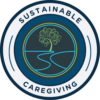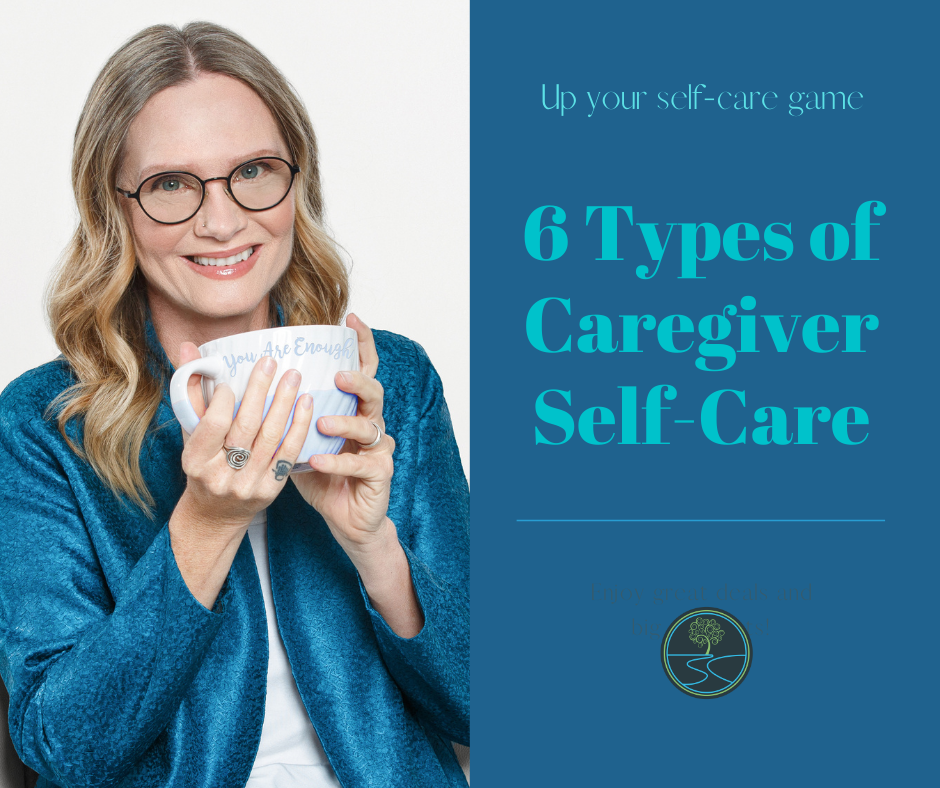Would you like to up your self-care game? As a caregiver, you likely hear a lot about self-care. The idea of fitting self-care into your schedule might even add unwelcome stress. When you know the different types of self-care, you can identify the missing components and add activities that will enhance your well-being.
Fun bonus: When you make a self-care plan, you are practicing practical self-care.
Emotional Self-care
Emotional self-care involves reflecting and processing emotions. Awareness helps us identify our emotions, and practice allows us to lean into them and work through them so that negative energy doesn’t accumulate.
Emotional self-care is essential because the roller coaster of emotions resulting from caregiving can impact our quality of life. When we regulate the uncomfortable emotions, we create space for joy and happiness.
Emotional self-care activities include setting boundaries, journaling, affirmations or mantras, counseling, and creating.
Practical Self-care
Practical self-care involves the work you do to prepare for upcoming events. When you develop a new system or strategy, you set yourself up for future success and less stress. When you create a routine, you organize your day to accomplish your priorities. An organized space facilitates completing tasks efficiently and with less aggravation. Organization and accomplishment produce feelings of calm and control.
Practical self-care is important because both engaging in these activities and the result bring a sense of calm and control to what can feel like the chaos of caregiving.
Activities include getting finances organized, researching a worry and making a plan, meal planning, and learning about an aspect of your family member’s medical situation.
Physical Self-care
Physical self-care involves a focus on the physical well-being of the body. Physical self-care may or may not involve movement; taking a nap is a self-care activity.
Physical self-care is important because movement releases endorphins that work together to improve our mood and help us feel better. Physical activity has been connected with better memory and thinking skills. When our bodies are well-rested and well-nourished, we are mentally sharper. Lower blood pressure has been associated with a healthy diet and adequate quantity and quality sleep. There is evidence that sleep helps control hormones that help the body regulate stress.
Activities include wellness visits, getting a massage, exercise, dancing, nutrition, hydration, and sleep.
Mental Self-care
Mental self-care involves engaging the brain and stimulating the mind. You might learn a new language, play a game of cards, learn, or teach a new skill. When listening to or playing music, the brain engages and cultivates creativity.
Mental self-care is crucial because learning and challenging our minds allows us to experience growth and feel relevant rather than stagnant. When we feed our curiosity by learning something new or solving a problem, we feel a sense of accomplishment. Our self-confidence gets a boost.
Stimulating the brain keeps it healthy and sharp so that we can make the many decisions required for ourselves and others throughout the caregiving day.
Examples include learning, reading, music, playing games, listening to a podcast, and solving puzzles.
Social Self-care
Social self-care involves events that help you connect with people to develop and deepen relationships. Opportunities for social self-care also include spending time with your furry friends. Playing with your pup enhances warm and fuzzy feelings of connection. Activities that cultivate feelings of love, gratitude, and connection enrich our well-being.
Social self-care is vital because, as social beings, we need connections to thrive. When we receive and offer help, our sense of belonging is strengthened and, in turn, our feeling of self-worth. When we connect from the heart, we can feel ripples of good vibes for days following the interaction.
Activities that help us nurture relationships include sharing coffee with friends, cuddling with your fur baby, an act of kindness, talking on the phone, and having lunch with a sibling.
Spiritual Self-care
Spiritual self-care involves connecting with and caring for your inner self. This connection grounds us because our true self is not aligned with ego or fear. Anytime you connect with what you consider meaningful, you deepen your relationship with yourself. The more time you spend nurturing your inner self, the more your intuition will guide you to activities that enrich a deeper connection. Take time to unplug from technology and link to your internal wiring.
Spiritual self-care is important because we feel empowered and fulfilled when we connect to who we are and our values. Anxiety is reduced when we calm our racing thoughts and give our minds space to just be. The tension dissipates, and our body relaxes as we go inward. Spiritual self-care practice carries over into our everyday interaction allowing us to be more mindful and less reactive.
Activities include meditation, time in nature, yoga practice, volunteering, creating a vision board, praying, taking time for stillness and reflection.
Caregiver Support System
When you have determined which self-care activities nourish your well-being, you can prioritize and protect them with routines and boundaries. You can start with one or two favorite interests and micro-dose self-care into your day. Add activities, one or two at a time, and build your Caregiver Support System.
Your self-care support system can evolve as often as needed based on changing circumstances. When caregiving responsibilities become more intense, activities may need to be adjusted, routines may need to be shifted and frequency modified to fit a more demanding schedule. When you know which activities sustain you and your well-being, you can re-imagine them to fit your ever-evolving reality.
For more on the 12 Sustainable Caregiving Strategies check out Navigating the Caregiver River: A Journey to Sustainable Caregiving, available on Amazon, and the Self-Caregiving Strategies Podcast.
Schedule Theresa Wilbanks to speak on caregiving and empower the caregivers in your workplace or community with the 12 Sustainable Caregiving Strategies.
Advice offered is for general information only; please contact your healthcare team, legal or financial advisors to guide your particular situation.


Great article, Theresa! I appreciate the breadth of self-care activities you addressed, even identifying things like practical and spiritual parts of life that people don’t always see as self-care as much as the physical and mental. I focus on emotional self-care, so I was pleased to see you listed that area first. Haha
Thanks Jill! I’m glad you found the information helpful! It is true that self-care encompasses a wide scope of activities. It opens up possibilities. For example, I love that working with Legos can be self-care. It’s also interesting how a self-care activity for some, such as cooking, may have the opposite effect on others and cause rather than alleviate stress. It is so important to find what works for you.
Pingback: Self-Care Beyond the Spa - Sustainable Caregiving™